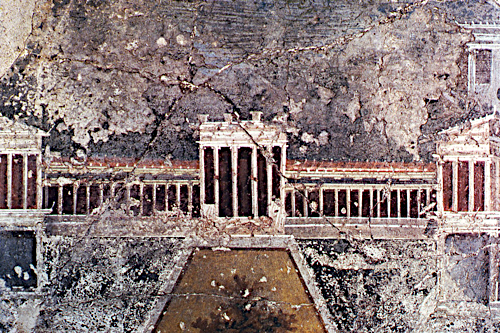Special Topics: Romans on Display

This course is designed to engage students in the special exhibition entitled "Leisure and Luxury in the Age of Nero: The Villas of Oplontis near Pompeii," currently scheduled to open at the Kelsey Museum of Archaeology in the Winter term of 2016. Oplontis, located a few miles from Pompeii, is home to one of the best preserved Roman villas that lined the shores of the Bay of Naples from about 50 BC until the eruption of Mount Vesuvius in AD 79. Villa A at Oplontis is often called the Villa of Poppaea on the assumption that the villa belonged to the family of Poppaea, the Emperor Nero's second wife. This villa houses some of the most splendid Roman wall paintings and marble sculptures known. Representative examples of these paintings and sculptures will be in the exhibition. In such villas, Rome's "one percent" engaged in entertaining friends and political cronies in a setting of cultivated leisure away from the hectic life in the city of Rome. In their villas wealthy owners put themselves on display amid a backdrop of colonnaded porticoes and gardens populated with sculptures, spacious reception halls, lavish wall paintings and mosaic floors, and other high-end accouterments that communicated their status and power to those they entertained. The exhibition, unlike others on Roman villas, also considers the roles played by slaves in maintaining this elite environment. A selection of objects that slaves would have used in serving their owners (such as kitchen pottery, glassware, oil lamps, bronze pitchers, an incense burner, etc.) will also be on display. Many villas entailed careful management and productive use of the resources of the surrounding land and nearby sea. Excavations at Oplontis have revealed a second structure, known as Villa B, a busy commercial establishment engaged in the lucrative wine trade. An elaborately inlaid storage chest from Villa B suggests that business was very successful. Skeletal remains of fifty-four people, several clutching considerable portable wealth (pearl and emerald-studded gold jewelry, gold and silver coins) were found in a room facing the waterfront, where these victims of the eruption awaited rescue. The exhibition will include the inlaid chest and selected examples jewelry and coins. It will raise questions of disparities of wealth and social status. Students will gain broad background in the types and significance of artworks and household objects that created the settings for the lifestyle of elite villa owners (e.g., banqueting, bathing, and the pursuit of intellectual and cultic interests) while exploring the social and political themes of the exhibition. Research papers and presentations on the objects in the exhibition will help students understand their significance in the lives of Roman elites and their slaves. Students will also learn about exhibition design and will have an opportunity to assist with educational programs for the public. No mandatory field trips outside Ann Arbor.
Textbooks/Other Materials: Exhibition catalog will serve as the textbook. Other reading materials for will be posted on CTools.
Estimated cost of materials: $50 or less.
HISTART Concentration distributions: 1. Ancient, D. Europe and the US